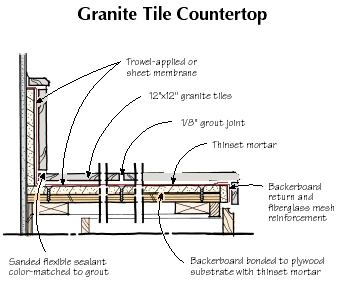- Q. We are planning to use 1-foot-square granite tiles in a kitchen counter application because it is more affordable than granite slabs. Can I install the granite right over plywood, or do you recommend Durock as an underlayment? What type of grout would work best? How wide a space should we leave between tiles? Thank you for any advice you can offer.
A.Michael Byrne, director of the Ceramic Tile Education Foundation, responds: I wouldn’t risk granite tiles over plywood. The best base to use is a backerboard made specifically for ceramic tile. This could be a cementitious backer unit, like Durock or Hardibacker, or a glass mat water-resistant gypsum board, like Dens-Shield.
The backerboard should be laid over a 3/4-inch exterior-grade plywood substrate, attached with a leveling bed of thinset mortar in between, and secured with Hi-Lo S Rock-On screws or galvanized roofing nails. Avoid the use of drywall screws.
For a counter that will get heavy use, you should also consider using a trowel-applied or sheet membrane over the cementitious backerboard and extending up into the backsplash area (Dens-Shield needs no further waterproofing).
As for grout, my recommendation is for a natural cement-colored grout mixed with a latex additive (or use a polymer-modified grout). Width is up to you. I usually recommend narrow joints (1/8 inch or less) because they’re easier to clean than wide joints.
Use a heavy-duty sealer as well (not a cheap silicone pour-on), and most important, include caulked expansion joints around sinks, cooktops, chopping blocks and at the joint between the top and the backsplash (see illustration).
Q&A: Granite Tile Countertops
Condensation on Ceiling
1 MIN READ
